Prevent Frozen Pipes in Winter: Expert Strategies
Prevent Frozen Pipes in Winter: Expert Strategies
Blog Article
What're your concepts on How to prepare your home plumbing for winter weather?

Cold weather can ruin your pipes, particularly by freezing pipelines. Below's just how to stop it from occurring and what to do if it does.
Introduction
As temperatures decline, the danger of icy pipes rises, potentially bring about expensive fixings and water damages. Recognizing how to avoid frozen pipelines is vital for property owners in chilly environments.
Comprehending Frozen Pipelines
What causes pipelines to ice up?
Pipelines ice up when exposed to temperature levels listed below 32 ° F (0 ° C) for expanded durations. As water inside the pipes ices up, it increases, putting pressure on the pipeline walls and possibly causing them to break.
Threats and damages
Icy pipelines can cause supply of water disturbances, building damage, and costly repairs. Burst pipelines can flooding homes and trigger extensive architectural damages.
Signs of Frozen Pipes
Determining icy pipelines early can prevent them from bursting.
Exactly how to determine frozen pipes
Search for lowered water circulation from taps, uncommon smells or sounds from pipelines, and noticeable frost on revealed pipelines.
Prevention Tips
Protecting prone pipes
Wrap pipes in insulation sleeves or use warmth tape to secure them from freezing temperature levels. Concentrate on pipes in unheated or external locations of the home.
Home heating techniques
Keep indoor spaces properly heated up, specifically areas with pipes. Open cupboard doors to permit warm air to distribute around pipelines under sinks.
Shielding Outside Plumbing
Yard hoses and outside taps
Disconnect and drain pipes yard hoses prior to winter months. Mount frost-proof spigots or cover outdoor taps with insulated caps.
What to Do If Your Pipes Freeze
Immediate activities to take
If you believe icy pipes, maintain taps available to soothe stress as the ice melts. Make use of a hairdryer or towels taken in warm water to thaw pipelines slowly.
Long-Term Solutions
Architectural modifications
Consider rerouting pipes away from outside walls or unheated locations. Add extra insulation to attic rooms, basements, and crawl spaces.
Updating insulation
Purchase top notch insulation for pipelines, attics, and wall surfaces. Proper insulation aids maintain regular temperatures and minimizes the threat of icy pipes.
Verdict
Avoiding frozen pipelines needs proactive actions and quick responses. By comprehending the causes, signs, and safety nets, house owners can secure their pipes during winter.
6 Proven Ways to Prevent Frozen Pipes and Protect Your Home
Disconnect and Drain Garden Hoses
Before winter arrives, start by disconnecting your garden hoses and draining any remaining water. Close the shut-off valves that supply outdoor hose bibs and leave the outdoor faucet open to allow any residual water to drain. For extra protection, consider using faucet covers throughout the colder months. It’s also important to drain water from any sprinkler supply lines following the manufacturer’s directions.
Insulate Exposed Pipes
Insulating your pipes is an effective way to prevent freezing. Pipe insulation is readily available at home improvement stores and is relatively inexpensive. Pay close attention to pipes in unheated areas such as the attic, basement, crawl spaces, or garage. Apply foam insulation generously to create a buffer against the cold. You can also wrap your pipes in heat tape or thermostat-controlled heat cables for added warmth.
Seal Air Leaks
Inspect your home for any cracks or openings that could let in cold air. Seal any holes around the piping in interior or exterior walls, as well as the sill plates where your home rests on its foundation. Additionally, make sure to keep your garage door closed unless you’re entering or exiting. Leaving it open creates a significant air leak that can lead to frozen pipes.
Allow Warm Air Circulation
During cold snaps, it’s essential to allow warm air to circulate evenly throughout your home. Leave interior doors ajar to promote better airflow. Open kitchen and bathroom cabinets to help distribute heat consistently around the rooms. If you have small children or pets, be sure to remove any household chemicals or potentially harmful cleaners from open cabinets for safety.
Let Faucets Drip
A small trickle of water can make a big difference in preventing ice formation inside your pipes. When temperatures drop significantly, start a drip of water from all faucets served by exposed pipes. This continuous flow helps prevent the water from freezing. Additionally, running a few faucets slightly can relieve pressure inside the pipes, reducing the chances of a rupture if the water inside does freeze.
https://choateshvac.com/6-proven-ways-to-prevent-frozen-pipes-and-protect-your-home/

We had been made aware of that report about 6 Ways to Prevent Frozen Pipes through a good friend on another web blog. In case you enjoyed reading our blog entry plz be sure to share it. Thanks a lot for being here. Return soon.
Click Here Report this page